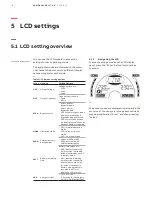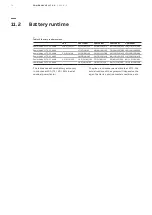
19
6 T R O U B L E SH O OT I N G
—
6 Troubleshooting
If the UPS system is not operating correctly,
check the operating status on the LCD display.
Table 12 below provides the problem, possible
cause, and possible solution for several warning
—
Table 12: Warning and fault codes
Warning &
Fault Code Problem
Possible cause
Solution
/
No indication, no
warning tone even
though system is
connected to mains
power supply
• No input voltage
• Breaker open
• Check building wiring socket outlet and input cable.
• Check the Breaker.
/
No Communication
data
•
RS232 wire is not
matched
• USB wire is not matched
•
Check or change the RS232 wire.
• Check or change the USB wire.
/
Emergency supply
period shorter than
nominal value
• Batteries not fully
charged
• Batteries defective
• Charge the batteries until fully charged.
• Change the batteries or consult your dealer.
FANF
Fan failure
Fan abnormal
Check the fan status; if the fan is not running properly,
report this to your local dealer / sales office.
HIGH
Battery over
voltage
Battery is over charged Switch to battery mode. Once the battery voltage is normal and the
mains is normal, the UPS will switch to line mode automatically again.
bLOW
Battery low
Battery voltage is low
• Charge the batteries until fully charged.
• Change the batteries or consult your dealer.
bOPN
Battery open
Battery pack is not
connected correctly
• Conduct battery test to confirm.
• Check the battery bank is connected to the UPS.
• Check the battery breaker is turn on.
CHGF
Charge fail
The charge is broken
Notify dealer.
dCHF
Digital bigger
charger fails
The charge is broken
Notify dealer.
bUSH
Bus high
UPS internal fault
Notify dealer.
bUSL
Bus low
UPS internal fault
Notify dealer.
bSFT
Bus soft start fail
UPS internal fault
Notify dealer.
bUSS
Bus short
UPS internal fault
Notify dealer.
TEPH
Inverter
temperature high
Inside temperature of
the UPS is too high
• Check the ventilation of the UPS.
• Check the ambient temperature.
ITPH
Inner Ambient
temperature high
The ambient
temperature is too high Check the environment ventilation.
INVH
Inverter high
UPS internal fault
Notify dealer.
INVL
Inverter low
UPS internal fault
Notify dealer.
ISFT
Inverter soft start fail UPS internal fault
Notify dealer.
NTCO
Inverter NTC open
UPS internal fault
Notify dealer.
SHOR
Inverter short
Output short circuit
1.
Remove all the loads.
2.
Turn off the UPS.
3.
Check whether the output of the UPS and loads are short circuited.
4.
Make sure the short circuit is removed, and the UPS has no
internal faults before turning on again.
OVTP
Over temperature
fault
Over temperature
• Check the ventilation of the UPS.
• Check the ambient temperature and ventilation.
OVLD
Overload
Overload
• Check the loads and remove some non-critical loads.
• Check whether some loads are failed.
SITE
Site fail
Phase and neutral
conductor at input of the
UPS system are reversed
Rotate mains power socket by 180° or connect UPS system.
EPO
EPO active
EPO function is enabled Plug into the EPO switch.
and fault codes. Use the table below for
troubleshooting purposes before contacting
the After-Sales Service Department.
If you are unable to troubleshoot the problem or find
a solution, have the following information on hand
before calling the After-Sales Service Department:
• Model number and serial number
• Date on which the problem occurred
• LCD display status and audible alarm status
• Mains power condition, load type and capacity,
environment temperature, ventilation condition
• Information (battery capacity, quantity) about
the external battery pack
• Additional information for a complete
description of the problem










































